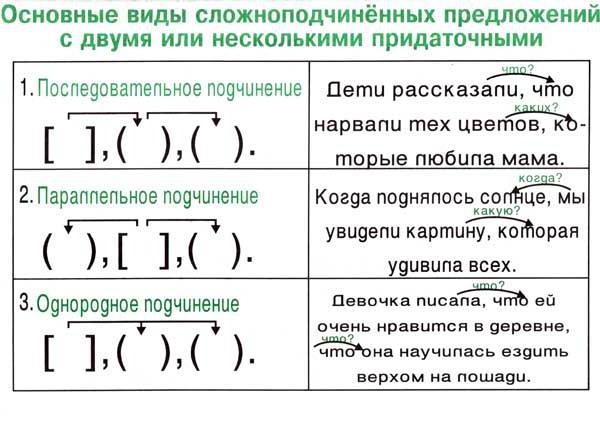SNP with multiple apparent: examples
Considers the structure of phrases and suggestions. At the same time, special difficulty usually causes design and punctuation registration of various types of complex proposals, especially with three and more predicative parts. Consider on specific examples, the types of NGN with several apparent, ways to communicate in them by the main and pressing parts, the rules for the formulation of punctuation marks.
Complexed offer: definition
To clearly express the thought, we use different proposals is characterized by the fact that it highlights two or more predicative parts. They can be equivalent to each other or to enter into relationships. NGN is such a proposal in which the pressing part obeys the main thing and joins it with the help of and / or allied words. For example, " [Stepka is very tired by the evening], (why?) (Since he passed no less than ten kilometers per day)" Hereinafter refers to the main part, round - dependent. Accordingly, in NGN with several apparers, no less than three predicative parts are isolated, two of which will be dependent: " [Locality, (what?) (Which was now passing), was well familiar with Andrei Petrovich], (why?) (Since good half of his childhood has passed here)" It is important to correctly determine the boundaries of simple proposals, where you need to put commas.
NGN with multiple apparent
A table with examples will help determine which types of complex proposals with three and more predicative parts are divided.
View of the subordinate part of the main | Example |
Consistent | The guys rushed to the river with a scatter, the water in which was already warmed enough, because the last days were incredibly hot. |
Parallel (inhomogeneous) | When the speaker finished talking, silence reigned in the hall, since the audience was shocked heard. |
Homogeneous | Anton Pavlovich said that reinforcement would arrive and what only you need to suffer. |
With different types of subordination | Nastya re read a letter for the second time, which trembled in her hands, and thought that she would now have to take off her studies that her hopes were not justified for new life. |
 We will understand how to properly determine the type of submission in the NGN with several apparent. Assist in this above examples.
We will understand how to properly determine the type of submission in the NGN with several apparent. Assist in this above examples.
Consistent submission
In a sentence " [Guys, we rushed into the river] 1, (water in which is already warmed enough) 2, (because the last days were incredibly hot) 3"First, we highlight three parts. Then, with the help of questions, we establish the semantic relationships: [... x], (in which ... x), (because ...). We see that the second part has become main for the third.
We give another example. " [The table was a vase with wildflowers], (who were gathered by the guys), (when they went to the forest on the excursion)" The scheme of this NGN is similar to the first: [... x], (which ... x), (when ...).
Thus, with homogeneous submission, each subsequent part depends on the previous one. Such NGNs with several additives are examples of this confirm - resemble a chain, where each subsequent link joins the located in front.
Parallel (inhomogeneous) submission
In this case, all the apparent refer to the main (to the whole part or the word in it), but respond to different questions and differ in value. " (When the speaker finished talking) 1, [the silence was reigned] 2 in the hall, (since the public was shocked heard) 3 " Let's analyze this NGN with several apparent. The scheme will look like this: (when ...), [... x], (as ...). We see that the first pressing part (it is before the main thing) means time, and the second reason. Consequently, they will answer different questions. The second example: " [Vladimir today certainly had to learn] 1, (in which hours the train arrives from Tyumen) 2, (in order to have a comrade) 3" The first pressing part is an exemplary, the second is the goals.
Uniform submission
This is the case when it is appropriate to carry out an analogy with another known syntactic design. For registration of PP with homogeneous members and such a NGN with several additive rules are the same. Indeed, in the sentence " [Anton Pavlovich spoke about] 1, (that reinforcement will arrive) 2 and (that you just need to suffer a little) 3»Pressure parts - the 2nd and 3rd - belong to one word, answer the question" What? " Both are extremely empty. In addition, they are interconnected using the Union and, in front of which the comma does not put. Imagine this in the scheme: [... x], (that ...) and (that ...).
In a NGN with several apparent subordinate to uniform subordination between the pressing parts, any writing unions are sometimes used - punctuation rules will be the same as when designing homogeneous members - and the subordinate union in the second part may be completely absent. For example, " [He was standing for a long time at the window and watched] 1, (how to house the car) 2 and (workers unloaded building materials) 3».
NGN with multiple subordination with different types of subordination
Very often, four or more parts are highlighted in a complex proposal. In this case, they can contact each other in different ways. Let us turn to the example given in the table: " [Nastya re-read the letter for the second time, (which trembled in her hands) 2, and thought] 1, (that now they will have to throw studies) 3, (that its hopes for new life were not justified) 4" This is a proposal with parallel (inhomogeneous) (P 1,2,3-4) and homogeneous (p 2,3,4) subordination: [... x, (which ...), ... x], (that ...), (that ... ). Or another option: " [All the way Tatiana was silent and just looked out the window] 1, (followed by small, closely located to each other villages) 2, (where people fussed) 3 and (boil the work) 4) ". This is a complex proposal with sequential (P 1,2,3 and P 1,2,4) and a homogeneous (n 2,3,4) subordination: [... x], (beyond which ...), (where ...) and (... ).
Punctuation signs at the junction of unions
To arrange in a complex sentence, it usually happens to correctly determine the boundaries of predicative parts. Complexity, as a rule, represents the punctuation of the NGN with several additives - examples of schemes: [... x], (when, (which is ...), ...) or [... x], [... x], (like (with whom ...), then ...) - When two subordination union (allied words) are nearby. This is characteristic of consistent submission. In this case, you need to pay attention to the presence of the second part of the double union in the proposal. For example, " [The disclosed book remained on the sofa] 1, (which, (if time left) 3, Konstantin would certainly read to the end) 2. "Second option: " [I swear] 1, (that (when I return from the trip home) 3, then I will definitely visit you and tell you about everything in detail) 2 ". When working with such a NGN with several additive rules, the following. If the second apprehensible can be excluded from the proposal without prejudice for the meaning, commaed between the unions (and / or is set, if not - is missing. Let's go back to the first example:" [The sofa lay a book] 1, (which was necessary to have time to finish) 2 ". In the second case, with the exclusion of the second suppression part, the grammatical system of supply will be disturbed by the word "TO".
To remember
A good assistant in the development of NGN with several apparers - exercises, the execution of which will help consolidate the knowledge gained. At the same time, it is better to act according to the algorithm.
- Carefully read the offer, designate in it the grammatical foundations and indicate the boundaries of predicative parts (simple proposals).
- Allocate all means of communication, not forgetting about composite or used near alliances.
- Install the semantic links between parts: To do this, first find the main one, then ask it the question (s) to the apparent (s).
- Build a scheme showing on it the addiction of parts from each other, put the punctuation marks in it. Transfer commas in the recorded offer.
Thus, attentiveness in constructing and analyzing (including punctuation) complex proposal - SPP with several apparent specifically - and the support on the features of this syntax listed above will ensure the correct execution of the proposed tasks.







